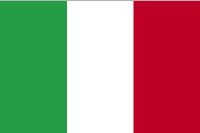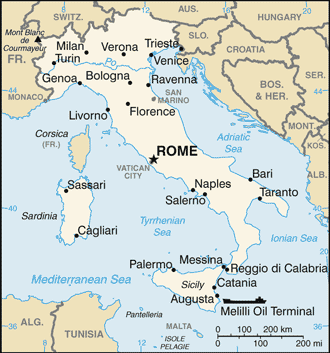Aug 30 2012
Italy is a peninsular country located in Europe to the South of Germany. It has a total area of 301,340 km2 and a population of 59,290,969, with a density of 202 p/km2 as of 2018. The country’s climate is mostly Mediterranean.
 |
The national flag of Italy.
Image Credits: CIA Factbook. |
The GDP of Italy had grown 0.3% in the fourth quarter of 2017, reaching $511,787 million. This placed Italy 8th in the quarterly GDP rankings out of 50 countries.
Italy has a variety of natural resources such as coal, zinc, potash, marble, barite, pumice, asbestos, fluorspar, mercury, feldspar, pyrite, natural gas, and crude oil reserves. The Italian government has complete control of its mineral industry.
The export of Italy's metal products has decreased from 3539.62 million Euros in December 2016, to €3310.41 million in January 2017. On average, between 2014 to 2017, the export of metal products totaled €3649.17 million.
During July 2015, metal product export was at its highest, at €4439.43 million. It reached its lowest in August 2015, at €2152.39 million.
Overview of Resources
Italy is a significant producer of industrial minerals such as cement, marble, feldspar, lime, clay, and pumice for global consumption. The metal industries produced copper, iron and steel, lead, and zinc, which are essential for the country’s manufacturing industry. Iron and steel industries are important contributors to the country’s revenue.
Italy’s mineral production statistics as of 2018:
- Pig Iron production - decreased by 3.9%
- Aluminum production - decreased by 21.99%
- Ferromanganese & Silicomanganese production - increased by 35.3% in 2010, no change since
- Crude steel production - increased by 1.39%
- Granite production - increased by 60%
- Feldspar production - increased by 12.55%
- Salt production - decreased by 28.99%
- No change in gold production

A Map of Italy. Image Credits: CIA Factbook
Metals
Italy is the world’s seventh-largest steel exporter. As of June 2017, Italy had exported 8.8 million metric tons of steel; a 0.4% increase from 8.77 million metric tons in 2016. Italy’s exports represented approximately 4% of all steel exported globally in 2016. The volume of Italy’s 2016 steel exports was slightly larger than that of Belgium, and just under one-sixth of the size of the largest exporter, China. In value terms, steel represented just 6% of the total amount of Italy's exported materials in 2016. Italy exports steel to over 170 countries and territories.
KME Group S.p.A., a European copper refiner and fabricator based in Florence, used its subsidiary KME Italy S.p.A. to conduct copper mining operations at Barga and Scrivia in 2010. The subsidiary in the same year produced mostly secondary copper and copper semi-manufactures.
Simar S.p.A. owned a refinery at Porto Marghera, Venice, where it mainly produced copper-zinc-titanium alloys in 2010.
Only a small amount of lead and zinc concentrate was produced in Sardinia in 2010, and the country had to depend on imports for its domestic needs.
Italy’s crude steel consumption in 2010 was 26.6 Mt, making it the second largest consumer of steel in the EU after Germany.
Small to medium reserves of antimony have been found in the Manciano area.
Industrial Minerals and Gemstones
Italy's industrial production grew by 3.6% year-on-year as of March 2018, following a 2.5% rise the previous month, and exceeding market expectations of 2.4%. Industrial Production in Italy averaged 0.08% from 1991 until 2018, reaching a high of 17.40% in August of 1994 and a low of -25.9% in March of 2009.
Italy was the 13th largest producer of cement in the world until 2010 when its cement production reduced by 5.3% due to the decrease in construction sector output.
Gemstones used in Italy are mostly cut materials, such as mother of pearls, type-C jades, malachite, onyx, cornelian, pink opal, and lapis. There is also some use of turquoise, coral, blue chalcedony, chrysoprase, amethyst, and London blue topaz. Other gems like peridot, garnet, tourmaline, beryl, and topaz are only used in more significant projects. There was 4% decrease in the export of jewelry, following the decrease of the global requirement for jewels in the Valenza district.
Italy’s Carrara and Sienese marbles are globally recognized for their natural qualities. Marble is also quarried at multiple locations from the Alps to Sicily. The most important white-marble-producing area is in the Apuan Alps, and it accounts for about one-third of Italy’s 100,000 t of white marble. The major colored-marble producing areas in the country are Sicily, Lazio region, Verona-Vincenza, Lombardy, Po Valley, Puglia, and Venice.
Fossil Fuels
Most of Italy’s fuel needs are met by imports. Almost 26% of its crude petroleum is imported from the African countries, and 25% comes exclusively from Libya.
According to the World Bank collection of development indicators, fossil fuel energy consumption in Italy was at 79.15% in 2015.
Italy’s major natural gas supplier is Russia - they provide 51% of natural gas imports, which are injected into the national network at Tarvisio and Gorizia. Libya and Algeria are the second most important exporters, both providing 13% of the natural gas imports. The entry point is Mazara del Vallo in Sicily. The Netherlands (8%) and Norway (5%) also provide a small amount of these imports.
Overall, natural gas produced in Italy is placed into the national network at 51 entry points, either from the collection and treatment plants or the production facilities. Italy also has various natural gas storage facilities connected to the network. 42% of the natural gas is distributed for civil use, and 52% is for industrial and thermoelectric use.
The transport of natural gas in Italy is carried out in two ways. 'Primary Distribution' involves transport through large pipelines at a national scale - a 29,300 kilometer-long gas pipeline network spans the whole of Italy, except for Sardinia. 'Secondary distribution' supplies gas locally through a widespread system. A new gas pipeline is currently being built to carry natural gas to Italy via Sardinia, from Algeria. This new pipeline, known as Galsi (Gasdotto Algeria Sardegna Italia), will be completed in 2018.
Investment
Italy is likely to continue relying on mineral fuel imports even though predictions indicate that there will be an increase in domestic production owing to the discovery of new deposits.
The Italian mining industry is suffering from low funding, and according to recent reports, miners of the Sardinia coal mine are resorting to extreme measures in protest against possible closure of the mine because of lack of investment, which will result in the loss of about 500 jobs.
Experts believe that the Italian economy will recover at a slow pace as there is a lack of investment sources in the near future. The Italian government will need to revamp its policies and focus more on showcasing its resources to the global community and investing more in its mining sector.
Disclaimer: The Author of this article does not imply any investment recommendation and some content is speculative in nature. The Author is not affiliated in any way with any companies mentioned, and all statistical information is publically available.
Sources and Further Reading
This article was updated on 24th May, 2018.